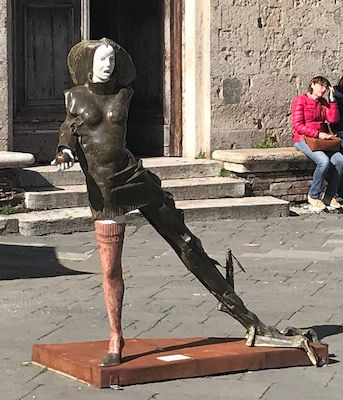"Woman on a Stroll" Exhibition
- Amy Unfried
- Apr 28, 2019
- 2 min read
The Siena streets are currently the venue for an exhibition of the work of sculptor Alberto Inglesi, on view from March 23 to May 8. The title, "Femmina in Cammino," means "woman on a stroll," and the show is billed as a "wandering exhibit." I read that there are 40 pieces in the show, dotted around the city, in a variety of public places. I saw them in piazzas, loggias, and little grassy areas, but I only encountered about a dozen of them in the four days during which I did quite a lot of walking around the small city. The ones I saw are probably enough of a sample to generalize about the whole show.
They all show women, at approximately life size. They incorporate a wide variety of materials: many of them are mixed media constructions, using such materials as ceramic (as faces, for example), glass, wood, cast bronze, and fabricated steel. The bronze may be painted realistically or patinated uniformly dark.

In two pieces I saw, the same bronze figure--head, torso and legs on tiptoe--was used for different compositions, colored differently, with different arms and different context in which the figure was confined.

In "Homage to Duccio"--the renowned 14th-century Sienese artist whose religious paintings are featured in the museums of the city--the head and torso are recognizably female, tapering down so the legs dissolve into a cone of horizontal strips, with abstract "wings" made of stained glass.

Another piece, titled "Cadmo e Armonia," shows two figures from Greek mythology, in a composition carved entirely out of wood, but the female figure dominates through her standing pose. It's the only multi-figure piece I saw.

All the pieces that I observed are standing poses, except for "Annunciation," in which the seated Mary figure extends her hand--but the dove is flying away from her. (Does this mean the Holy Spirit's message has already been delivered and its job is done?)

In "Dafne," the screaming figure of the nymph tries to escape being raped by Apollo, besotted with her, so her father, a river god, is turning her into a laurel tree; you can see that her left leg hais already partly undergone this metamorphosis. This piece might be my favorite.
I'm not sure what statement the artist is making with this array of interpretations of women, but if it is that women are all unique and generally fascinating, I could agree with him.



Comments